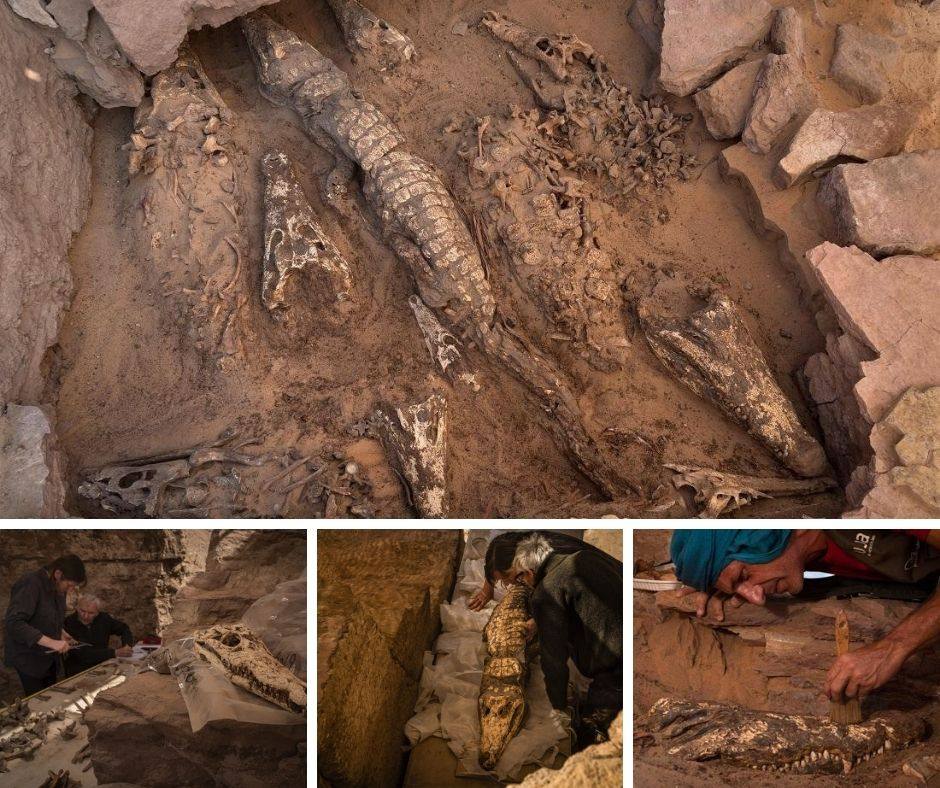Ten 2,000-Year-Old Mummified Crocodiles Unearthed in Egypt

In 2019, archaeologists from the University of Jaén uncovered one of the most fascinating discoveries in recent Egyptian history: a tomb at Qubbet el-Hawa, near Aswan, containing ten mummified crocodiles preserved for over 2,000 years. The find stunned both the archaeological and scientific communities, not only for its rarity but also for what it reveals about the deep connection between ancient Egyptians, their environment, and their gods.

Sacred Offerings to Sobek
The crocodiles, some preserved as complete skeletons and others represented by skulls, were likely offerings to Sobek, the ancient Egyptian Nile god associated with fertility, protection, and power. Sobek was often depicted as a man with the head of a crocodile, embodying the might of the Nile River and the life it sustained.
The careful placement of these crocodile remains inside the tomb suggests that they were intended either as sacred offerings or as guardians for the tomb’s occupant, ensuring protection in the afterlife. This practice reflects the Egyptians’ belief that animals could act as divine mediators between the mortal world and the spiritual realm.
Unveiling Ancient Rituals
Animal mummification was a widespread religious practice in ancient Egypt, extending beyond crocodiles to include cats, ibises, falcons, and even dogs. Each species was linked to a deity and was honored through rituals and offerings. The discovery of the mummified crocodiles at Qubbet el-Hawa adds to our understanding of how Egyptians integrated the natural world into their religious practices, treating animals not only as symbols but as sacred vessels of divine power.

The five complete crocodile skeletons are especially valuable, as they show the scale and detail of the mummification process. Unlike some animal mummies wrapped in linen, these reptiles were buried largely intact, allowing researchers to study their anatomy and preservation with unprecedented clarity.
Bridging Archaeology and Natural Science
Beyond religion, the crocodile mummies also provide crucial data for zoology and climate studies. By analyzing the remains, scientists can learn more about the species of crocodiles that lived along the Nile thousands of years ago, some of which may now be extinct or relocated due to environmental change. Additionally, the find offers evidence of how climate and river ecosystems shifted in antiquity, influencing both wildlife and human settlement patterns.
This blending of archaeology and natural science makes the Qubbet el-Hawa discovery especially significant. It highlights how ancient practices can inform modern disciplines, offering insights into biodiversity, ecology, and cultural adaptation.
Conclusion
The unearthing of ten 2,000-year-old mummified crocodiles at Qubbet el-Hawa is more than a remarkable archaeological discovery—it is a window into the complex spiritual and ecological world of ancient Egypt. Honoring Sobek, the god of fertility and strength, these crocodiles stood as guardians and sacred offerings, symbolizing humanity’s deep respect for the forces of nature. Today, their remains not only enrich our understanding of ancient rituals but also provide scientists with valuable clues about Egypt’s changing environment. In their silence, these crocodiles continue to speak—bridging past and present, myth and science.








